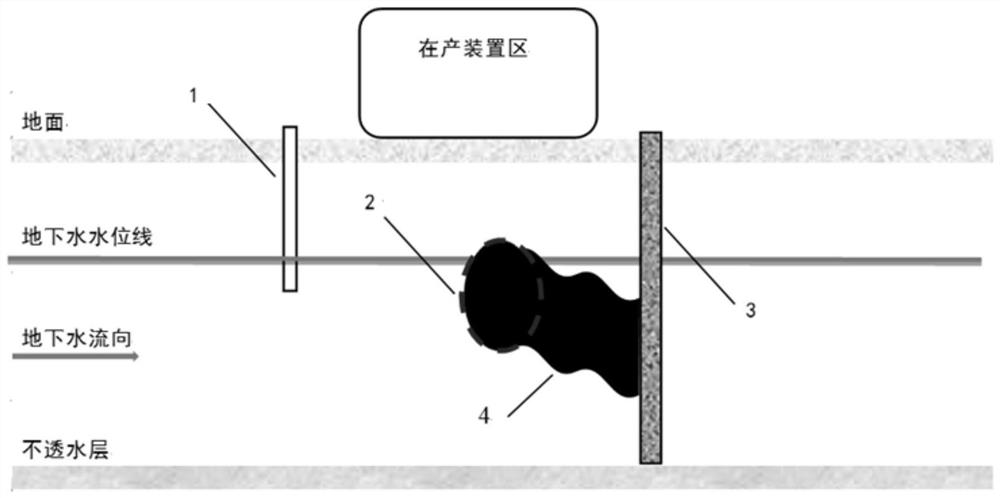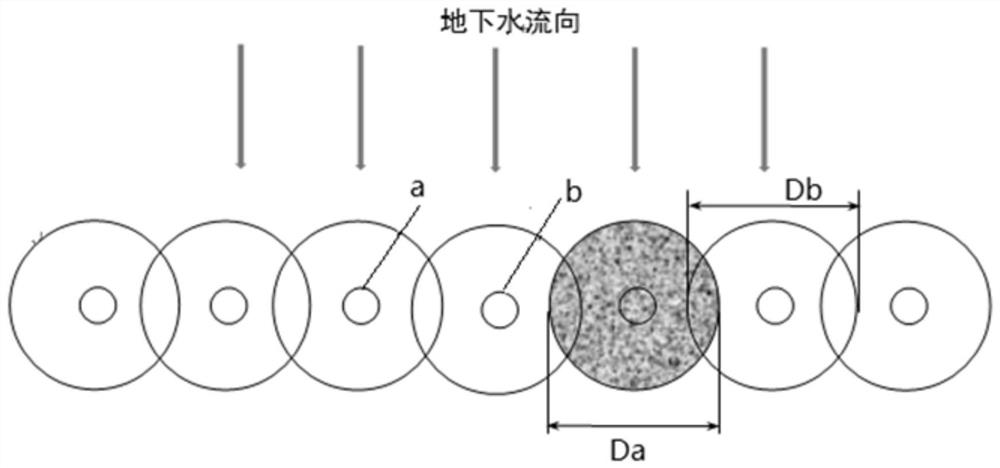Method for remediation of contaminated soil and groundwater
A technology for polluted soil and groundwater, applied in the restoration of polluted soil, etc., can solve the problems of time-consuming and labor-consuming, slow migration, poor heat transfer effect, etc., and achieve the effect of shortening repair time, low construction cost, and concentrated reaction
- Summary
- Abstract
- Description
- Claims
- Application Information
AI Technical Summary
Problems solved by technology
Method used
Image
Examples
Embodiment approach
[0032] In the present invention, the injection well is built upstream of the groundwater in the polluted area, and is used to inject the surfactant slurry into the groundwater, so that the surfactant migrates into the polluted area along with the groundwater. When constructing the injection well, the depth of the well should be dug below the groundwater level. The present invention has no special limitation on the specific construction method and specifications of the injection well, which can be selected with reference to the prior art. According to one embodiment, the injection well has a diameter of 5-10 cm.
[0033] In the present invention, the pollutants in the contaminated area comprise volatile and / semi-volatile organic compounds. Specific examples of the pollutants include, but are not limited to, one or more of diesel, gasoline, benzene, toluene, di-n-octyl phthalate, and benzo(a)pyrene.
[0034] In the present invention, the surfactant may be a nonionic surfactant...
Embodiment 1
[0059] Diesel leakage from a buried pipeline at a gas station caused pollution. Before implementing this method, the total petroleum hydrocarbon (C10-C40) content in the soil in the polluted area was 20034 mg / kg, which exceeded the screening value for the second-class land in GB36600-2018 4500mg / kg, the benzene content of groundwater is 963μg / L, exceeding the conventional index limit of 120μg / L for Class IV water in GB / T14848-2017. The total petroleum hydrocarbon (C10-C40) content in the soil at the intermittent reaction wall was 8832 mg / kg, and the benzene content in the groundwater was 478 μg / L.
[0060] Build an injection well upstream of the groundwater in the polluted area. The diameter of the injection well is 5cm. A row of injection holes is constructed in the downstream of the groundwater in the polluted area perpendicular to the ground and groundwater flow. The diameter of the injection hole is 5cm. The construction between the holes The distance is 1m, the filling pi...
Embodiment 2
[0064] A leak occurred in the buried pipeline of a sewage pool, which caused the sewage containing dioctyl phthalate to seep into the ground. Before implementing this method, the content of dioctyl phthalate in the soil in the polluted area was 7498 mg / kg, exceeding GB36600-2018 stipulates that the screening value of Class II land use is 2812 mg / kg, and the content of di-n-octyl phthalate in groundwater is 669 μg / L, exceeding the unconventional index limit of 300 μg / L for Class IV water in GB / T14848-2017 . The content of dioctyl phthalate in the soil at the intermittent reaction wall was 5537 mg / kg, and the content of dioctyl phthalate in the groundwater was 492 μg / L.
[0065] Build an injection well upstream of the groundwater in the polluted area. The diameter of the injection well is 10cm. A row of injection holes is constructed in the downstream of the groundwater in the polluted area perpendicular to the ground and groundwater flow. The diameter of the injection hole is 5...
PUM
 Login to View More
Login to View More Abstract
Description
Claims
Application Information
 Login to View More
Login to View More - Generate Ideas
- Intellectual Property
- Life Sciences
- Materials
- Tech Scout
- Unparalleled Data Quality
- Higher Quality Content
- 60% Fewer Hallucinations
Browse by: Latest US Patents, China's latest patents, Technical Efficacy Thesaurus, Application Domain, Technology Topic, Popular Technical Reports.
© 2025 PatSnap. All rights reserved.Legal|Privacy policy|Modern Slavery Act Transparency Statement|Sitemap|About US| Contact US: help@patsnap.com


